Table of Contents
The Event
On Thursday, March 2nd, I had the pleasure of inviting 60 experienced professionals throughout different industries to an Innovation event complete with the launch of the book “How To Create Innovation” published by Stefan F. Dieffenbacher. Here I would like to express my gratitude to Digital Leadership AG and Trust Square for supporting the event and providing a venue so conveniently located near Paradeplatz, the center of Zurich’s Banking district.
Attendees from around 30 companies located in the broader Zurich area joined us to discuss topics related to Innovation and Digital Transformation, to listen to Stefan presenting a selection of topics from the book, learn from a panel of industry and technology experts, and of course to network over a glass of wine.

Those who have joined us, as well as those who want to get an idea of the spirit of the event, can browse through the picture here (thanks to the photographer Edward Metzler):
To View Impressions from the Innovation & Book Launch Event in Zurich Visit: https://digitalleadership.com/zurich-book-event/
The Book
Organisations that stay safe and avoid risk get left behind, whilst those that take chances and seize opportunities succeed
Stefan F.Dieffenbacher

In this comprehensive guide to leading innovation Stefan F. Dieffenbacher and his co-authors show you how to become an organization that plays to win. The only book on business innovation you will ever need, it is a truly practical guide to drive innovation and digital transformation in your organization.
The book brings together a wealth of experience from 60+ distinguished innovation leaders globally. Uniquely, this team has written the very first book on innovation that covers all domains and is end2end. The book is applicable to organizations of all types.
“How To Create Innovation” brings together all of the working methods, separate business innovation models and processes necessary for a successful innovation approach; including 50+ ready-to-use innovation tools, models and canvases, which you can download and immediately apply in your organization.
Each of the models presented in the book were developed under the Understanding and Navigating Innovation and Transformation in Enterprises (UNITE) umbrella – a business and innovation strategy that reminds us that when we UNITE, we are greater than the sum of our parts.
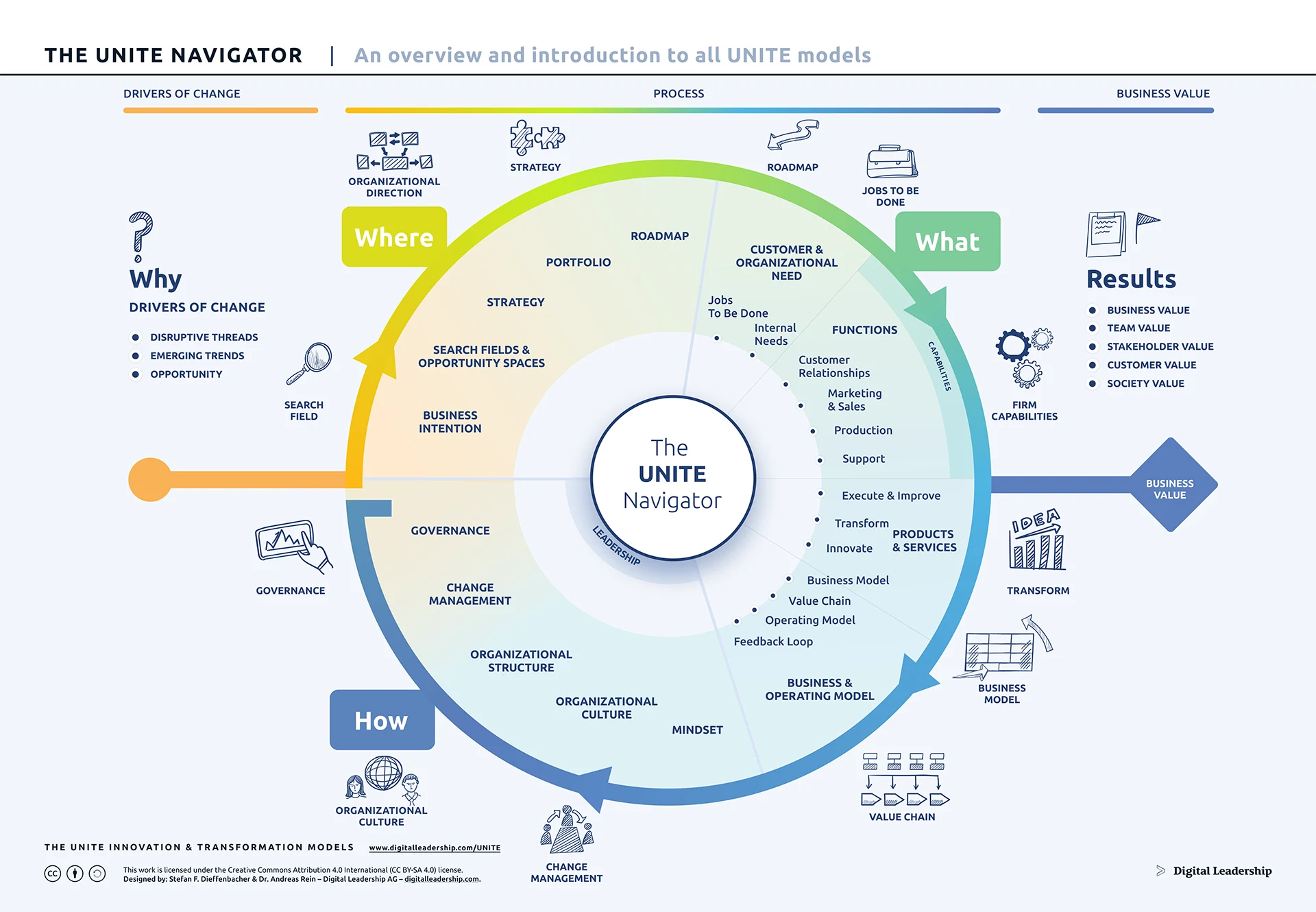
Designed by: Stefan F.Dieffenbacher & Dr.Andreas Rein – Digital Leadership AG
The Presentation – Selected topics from the book
Stefan F. Dieffenbacher gave a short introduction to the history of Change in society and business, especially showing that the life expectancy of successful companies is historically getting shorter partly due to shorter innovation cycles. Companies that fail to keep up are losing relevance.

Source: Foster & Kaplan (2001), Innosight, Standard & Poor’s
The UNITE Building Blocks of Digitalisation
He also stressed the importance to include all relevant building blocks of a digital transformation into any change initiative, as those are strongly interconnected and failing to doing so will open the door for issues that will endanger the whole undertaking.
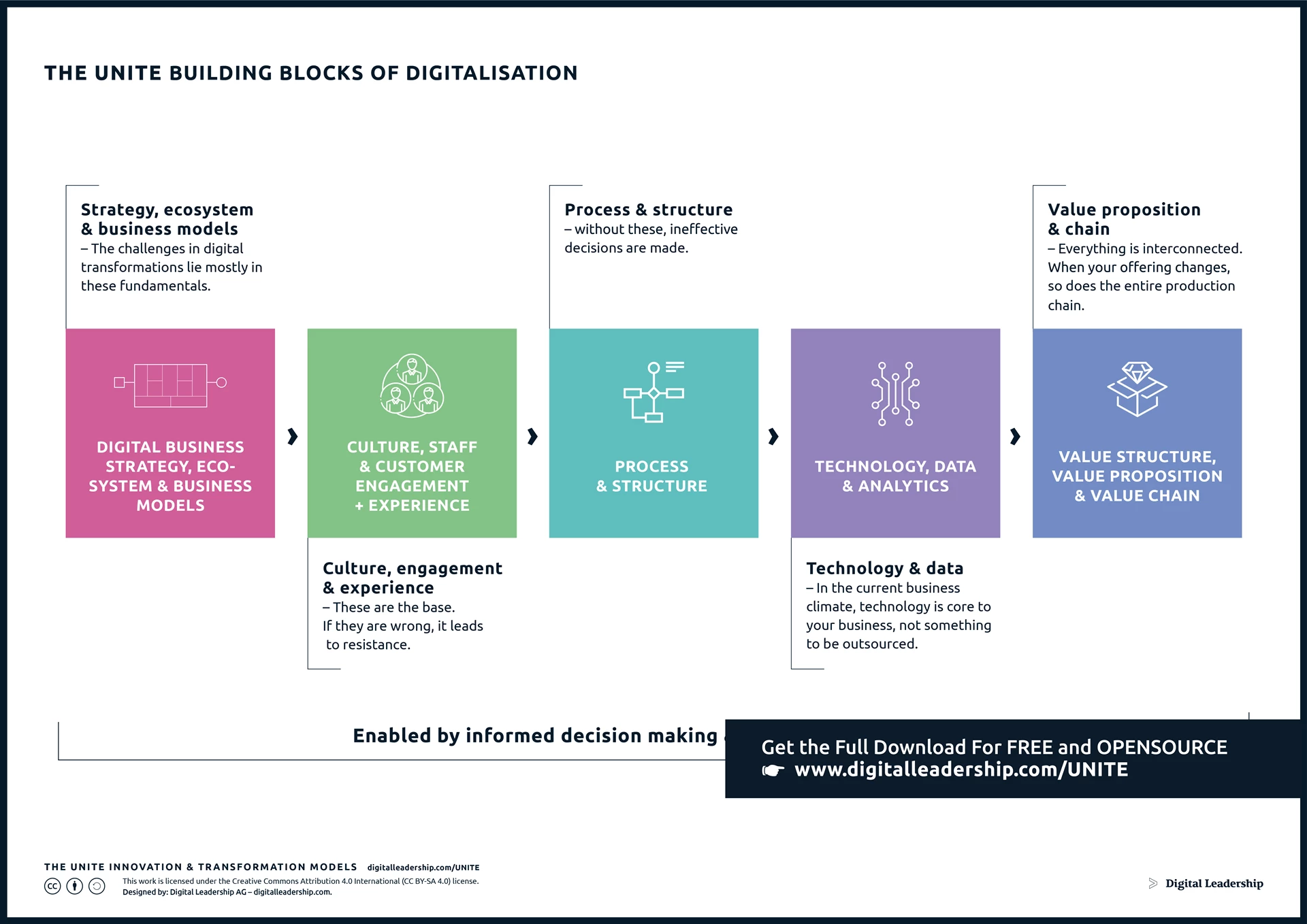
Designed by: Digital Leadership AG
Stefan then chose a selection of topics from the book which are key for successful innovation, but are typically not sufficiently understood by innovating companies:
- The 3 Horizons of Growth
- Playing your strengths
- Understanding your customer’s needs
- Business Model Innovation
- A New Understanding of Digital Transformation
- Where to innovate & where to cut costs
Here is a short summary:
The 3 Horizons of Growth
Create a winning setup (and stop if you don’t have one)
Stefan F. Dieffenbacher
To be an organization that successfully manages its core and creates new things, an organization needs to allocate its resources across 3 Horizons – it must keep its day-to-day business running while transforming its core business and creating new business models. Thus, each horizon is defined by whether it is working to improve an existing business, transform an existing business, or search for / innovate entirely new business models.

Designed By: Digital Leadership AG
- Improve – Horizon 1: Improving a business (model) means making incrementally small changes in order to execute your current systems and processes more effectively. This is well understood, since this is what most people work on every day.
- Transform – Horizon 2: Transforming an existing business (model) is focused on evolving your existing business in new ways – you seek to change at least one part of your business model in a more significant way, i.e., a step-change.
- Innovate – Horizon 3: Innovating a new business model is focused on radical innovation – you venture beyond and explore unknown business models through an innovation of the business model itself.
As you can imagine, each horizon requires a different approach, different management, different tools and different goals.
Related: The Three Horizons of Growth Model: A Roadmap to Successful Innovation Strategy
Playing your Strengths
Understand your company’s strengths and play to those
Stefan F. Dieffenbacher
Of course, we would like to think that we possess strengths in all the aspects of our company, but in order to identify our key strengths we have to ask ourselves, which ones really make a difference. Which ones differentiate us from our competitors?
To understand the distinction, imagine dividing your organization into Non-Core, Core, and Differentiating activities.
- Most of your organization is made up of Non-Core Activities (approx 80%) that do not add to your differentiation or your core business. So, you, as any other organization, are thus well-advised to apply standard practices to these areas where you do not differentiate in. This, in turn, will drive down costs, increase efficiency, and allow you to focus your attention on areas where you can differentiate.
The Business Strategy to apply in Non-Core Areas is to apply standard practices, improve operational excellence, reduce costs, to digitize wisely and strategically outsource. - Your Core Areas are industry specific where you possess relative strengths and where you compete head-to-head with your close competitors. However, they do not provide competitive advantage, since your core is not superior to your competitors’ core. So, the business objective here is to keep up as to defend your core but streamline where possible. From a business strategy perspective, the objective is to improve, but also to transform based on your strong core. Consider moving into adjacent areas, leveraging additional hidden capabilities and expanding into untapped segments and markets.
- Now contrast these with your Differentiating Areas. These are the few areas that really set you apart from your competitors, typically about 5% of your business. They are the source of your competitive advantage and support your ability to command a premium price. For these very few activities, your Business Objective should be to strive for best possible capability and continuing investing to increase differentiation. You can achieve increased differentiation through Business Model Innovation, since the business model is, as we discussed, most difficult to imitate.

Designed By: Digital Leadership AG
To summarize, when we are looking for strengths that support innovation, we need to be looking for assets and capabilities that are Core or, ideally, Differentiating, since these will support your competitive advantage.
The distinction between Core and Non-Core is critical: most firms do not make that distinction. But it is precisely that distinction that allows you to understand where to cut cost and where to invest, where to focus on differentiation and where to standardize.
Related: Strategy Execution Framework – A Guide to Successful Strategy Execution
Understanding your customer’s needs
Understand your customers important but underserved needs
Stefan F. Dieffenbacher
Companies often build new products that no one wants! As a result, most organizations lack the understanding of what their customers truly need and thus miss critical opportunities.
The customer’s unmet need should be at the heart of your innovation process. That is why we use Jobs to be Done to identify it. These tools help you articulate the customer’s basic job and then discover the smaller tasks that customers will need to do to meet it.

Goal is to create a successful and customer-centric innovation process. Solving a problem for a customer is not only the best way to ensure that you aren’t wasting resources building something that no one wants; it’s the key to designing a truly innovative product and operating in a blue ocean.
Related: Jobs to be Done Examples, Theory and Statements
Business Model Innovation
The UNITE Business Model Canvas – an iteration of Alexander Osterwalder’s original canvas – lays out the key parts of your business, including the:
Value Model – covering your different Value Propositions and related offers.
Service Model –The differentiating, core and non-core services delivered by an organization in support of their product.
Operating Model – Your approach to delivering your Value Proposition, broken into Value Chain, Key Resources, and Key Partners.
Experience Model – The ways in which your customers experience your Value and Service Models, divided into Brand, Customer Relationships, Customer Engagement, and Channels.
Revenue Model – The ways your business earns money.
Cost Model – The resources you expend supporting the other aspects of the business.
The canvas allows you to see how the different areas connect, and as you iterate one part, you can think through how changes there affect the other aspects of the Business Model.

Designed by: Digital Leadership AG – Building on the work of Alexander Osterwalder
The book «How To Create Innovation» is unique as it allows to zoom in or out of the Business Model Canvas to either work on the details of each key part, or to identify the larger contexts.
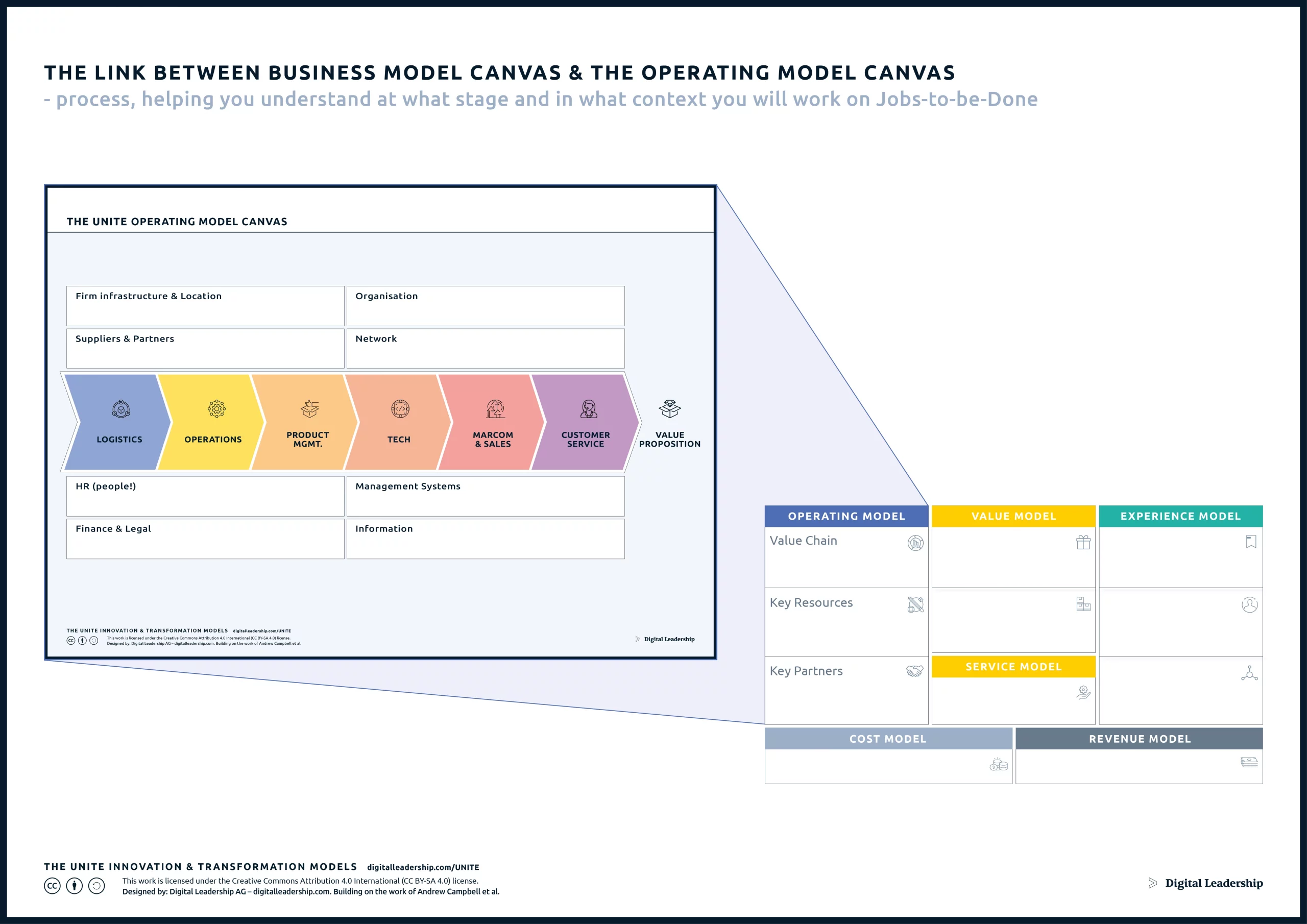
Designed by: Digital Leadership AG – Building on the work of Andrew Campbell at al.
Related:
- The Business Model Canvas Template – Full Guide (PPT + PDF)
- Business Model Innovation – How to Innovate Your Business Model?
A New Understanding of Digital Transformation
(Re-)configure your business model properly when you transform
Stefan F.Dieffenbacher

Designed by: Digital Leadership AG – Building on the work of Alexander Osterwalder
A digital Transformation is typically initiated in one of the Business Model Canvas key parts – it could be, for example, the addition of a new channel (online) in the “Channels” section. This will trigger adjustments in other sections, which will again trigger further adjustments. The main goal is to find a new consistent equilibrium that fulfils the set goals.
Where to innovate & where to cut costs
Save costs in the non-core and innovate where you differentiate
Stefan F.Dieffenbacher
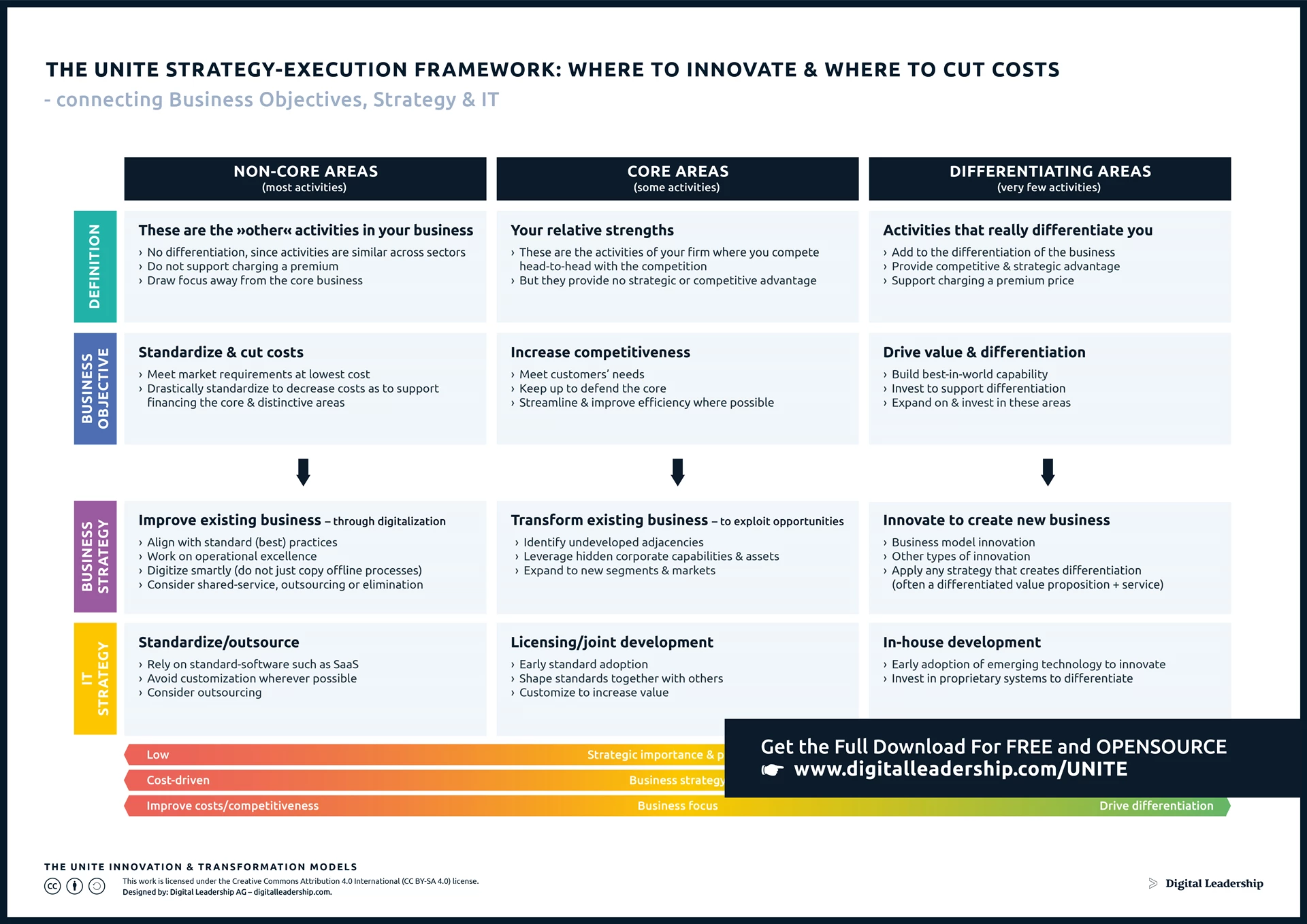
Designed By: Digital Leadership AG
A highly relevant question, especially in times of market pressure.
As already mentioned in the section “Playing your strengths”, knowing the core, non-core and differentiating areas allows to decide where costs can be reduced without a major impact on the competitiveness of the company and where this can lead to the loss of important strengths. Many companies tend to prescribe a slimming diet across the board (“every unit has to cut costs by 10%”) without being aware of the short- and long-term consequences.
The Panel
Of course, one highlight of the event was the panel discussion with senior experts from the industry, services- as well as technology-providers!
We were pleased to welcome the following gentlemen to an exciting discussion that quickly included the high-calibre audience resulting in a spontaneous and lively conversation.
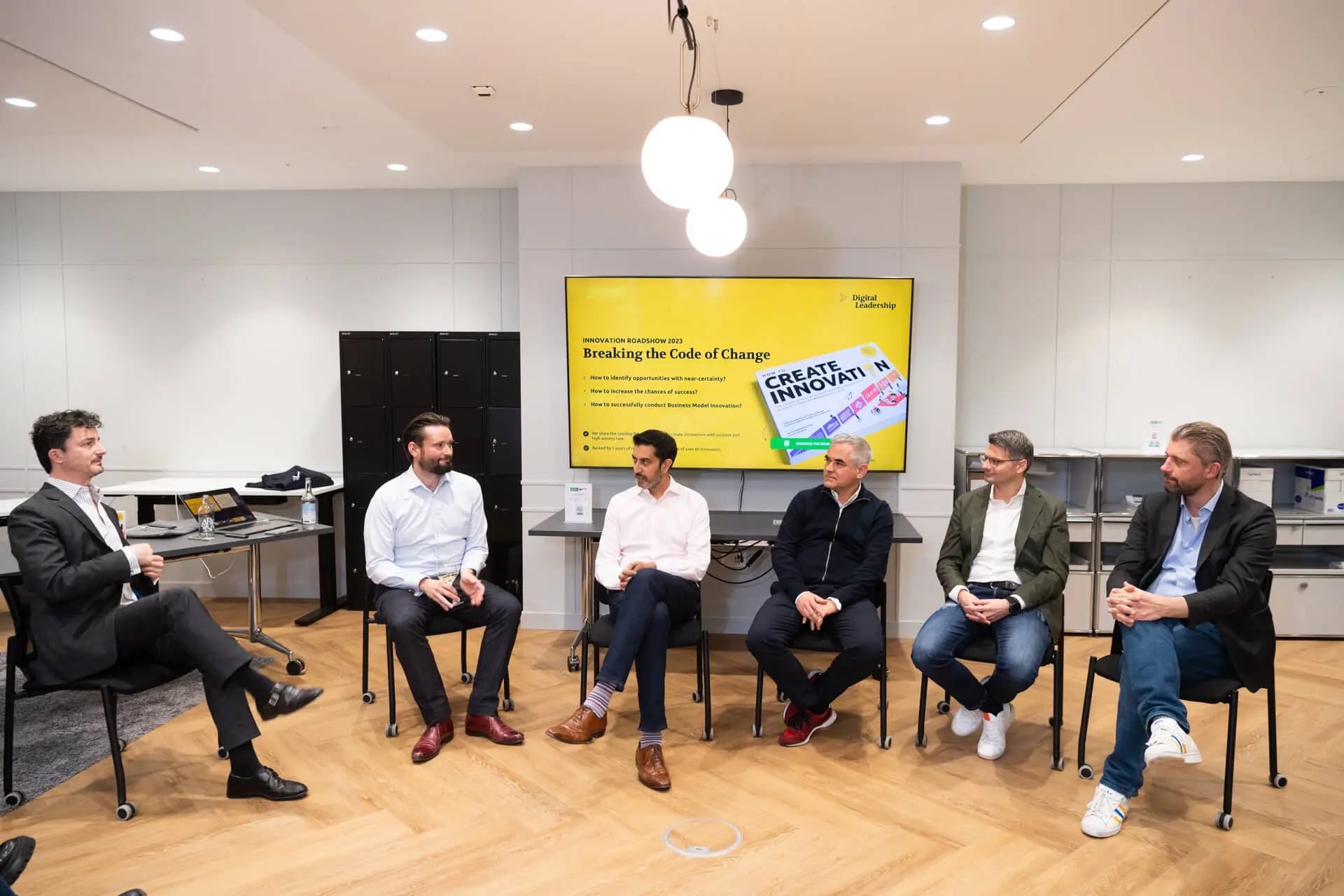
From left to right:
Adam D. Wisniewski
Partner at Digital Leadership
Stefan F. Dieffenbacher
Lead author of the book & innovation veteran
Chetan Tolia
Head of UBS Next, the venture and innovation unit of UBS
Markus Kienberger
ex-Country CEO Google,Management Consultant
Tobias Bergtholdt
Practice Lead – Financial Services at Amazon Web Services (AWS)
Marc Degen
Book contributor & founder of Trust Square
Many topics were discussed – For example, in response to the first question about what underlies a successful innovation initiative, Chetan mentioned the need for “unlearning”; for Markus, a hiring strategy which considers both skills and mindset was central; Tobias talked about the approach at AWS, where culture and processes throughout the company foster innovation; and for Mark, a serial company founder, “guts”, i.e. the courage to push boundaries but also to allow failure, were vital.
However, it must be mentioned that everyone recognized the importance of proven approaches and frameworks, without which even the best endeavour too often fails.
The Conclusion
I can confidently state that the event was a great success – participants gave feedback that both the topics were relevant and the discussions exciting. Of course, we now hope that the insights will be carried into the respective companies and will contribute to their success.
We at Digital Leadership are happy to support this process. And so we look forward to meeting one or the other participant again soon in a different setting.
[optin-monster-inline slug=”envstg0utdy2ioxyviul”]Finally, the attendees didn’t go home empty-handed! Everyone has received a code for a complimentary digital version of the book, thus laying the best foundations for successful future development! And in underlines Digital Leadership’s motto to be “The World’s First Open Source Consultancy”. If you would like to learn more about the book, the topics presented above or Digital Leadership as a company, please visit our website and do not hesitate to contact me!
Adam D. Wisniewski
Partner at Digital Leadership
aw@digitalleadership.com































 Book How to Create Innovation
Book How to Create Innovation